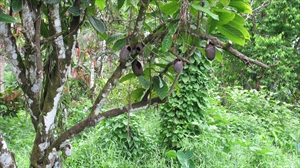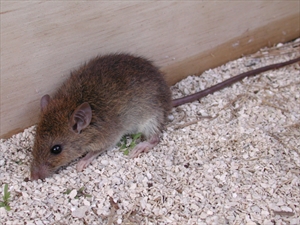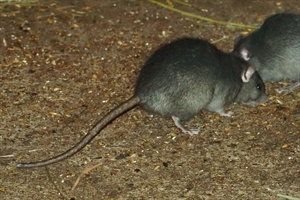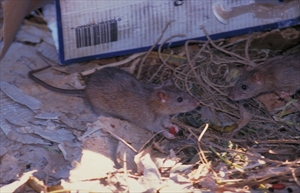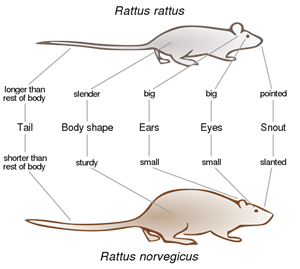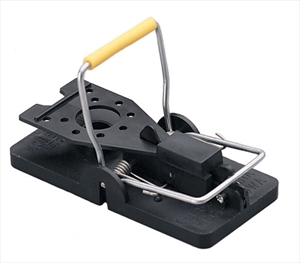Polynesian rot, black rat (also called ship rat), brown rat
Pacific Pests, Pathogens and Weeds - Online edition
Pacific Pests, Pathogens & Weeds
Rats (035)
Rattus exulans (Pacific rat); Rattus rattus (black rat); Rattus norvegicus (brown rat).
Rattus exulans - widespread through Asia and the Pacific islands; Rattus rattus - worldwide; Rattus norvegicus - worldwide with human settlement.
Main crops that are attacked are cassava, cocoa, coconut, oil palm, peanut, maize, rice, sweetpotato, and others in storage.
Habitats: All three species can be found in grasslands, scrub, forests and urban areas. The Polynesian rat does not burrow, but digs small holes and nests mainly on the ground. The brown rat makes burrows and nests underground. The Polynesian and black rat climb, the brown rat rarely does. Black rats often nest in trees. The brown rat swims well, and favours wet habitats. In Pacific islands countries, it is probably more common in ports and towns than village gardens.
Life Cycles: If food is available, rats breed. Females can reproduce several times a year. Sexual maturity is 2-3 months, gestation (period between fertilization and birth) is 21-24 days and average litter size is 6-10. Life expectancy is 12-15 months.
All three damage crops, and are a threat to biodiversity. Apart from fruits, grains and other plant material, these rats eat insects, reptiles and young birds. They are pests of agriculture crops, including rice, maize, sugarcane, coconut, cocoa (Photo 1), pineapple, peanuts and root crops. They eat stored foods, and spoil them by urinating and defaecating on them. Rats carry a scrub typhus in Santa Cruz, Solomon Islands, which is transmitted via the fleas they carry.
Note, damage in coconuts is not directly related to the number of nuts damaged; it occurs early and palms compensate for about 50% of the loss. In cocoa, this is not the case as damage occurs when pods are near maturity.
Characteristics of the three species are listed as follows:
Polynesian rat (Photo 2):
- Slender body, pointed snout, large ears; relatively small, delicate feet.
- Red-brown back and white underneath.
- Body weight 40-80 g; up to 15 cm long - tip of the nose to the base of the tail.
- Tail has prominent fine, scaly rings, about the same length as the head and body.
- Has a distinctive dark band on the edge of the hind foot near the ankle.
- Females have eight nipples.
Black rat (Photo 3):
- Slender body, large hairless ears.
- Grey-brown on the back; either a similar colour or creamish-white underneath or all black.
- Body weight 120-160 g, but it can exceed 200 g; up to 20 cm long.
- Tail is one colour; it is always longer than the head and body length combined.
- Females have 10 nipples.
Brown rat (Photo 4):
- Small ears - which usually do not cover the eyes when pulled forward.
- Brown on the back, pale grey beneath.
- Body weight 150-300 g, but can reach 500 g; up to 25 cm long.
- Tail is scaly and shorter than the head-body length.
- Females have 12 nipples.
A comparison between the black and brown rat is provided (Diagram).
CULTURAL CONTROL
- Band coconut trunks with an aluminium strip (30 cm wide at least 2.5 m from the ground) to reduce rat damage in plantations.
- Do not leave household waste for rats to eat; otherwise, populations will remain high. Good sanitary practices are essential in villages and towns.
PHYSICAL CONTROL
- Snap-traps (Photo 5) are efficient, especially if they are left with food but unset for a few days before being set properly. Bait shyness can be a problem. The traps should be put where children and pets cannot get to them.
- Probably the best means of control is a cat!
CHEMICAL CONTROL
Plant-derived pesticides:
- Gliricidia (the legume shade tree). Pound young leaves and mix with cooked rice, maize or other bait. Bacteria convert chemicals in the leaves to substances similar to brodifacoum. These are less toxic than brodifacoum, so larger amounts must be eaten. Try using the bark. Change the bait daily, and protect from pets.
- In Reef Islands, Solomon Islands, the white inner flesh of Barrintonia asiatica fruits (4-sided on trees along seashore) are scraped, added to cooked rice or shredded coconut, and used as a rat poison.
Commercial pesticides:
- Use the anticoagulants (prevent blood clotting), warfarin and brodifacoum, made into baits with coconut, wheat or maize. Warfarin is less toxic.
- Prevent baits from being taken by other animals, cats and dogs in particular, but also by birds. Put baits in pipes or bamboo sections. Ideally, collect baits in the morning and put them out in the evening. Resistance to warfarin is known.
- Make warfarin (0.025-0.05% w/v) into waterproof blocks (80 g) with paraffin wax and bait, and tie to branches of trees. Place 25-30 sites per ha.
- Use brodifacoum (0.005% w/v) as ready-made pellets containing bait. Less is needed per station. Read the label or seek expert advice.
Note warfarin is banned in Europe and, in the USA, so-called second generation anti-coagulants, e.g., brodifacoum, can only be used by professional pest control operators. Warfarin and brodifacoum are registered in all states and territories in Australia, but brodifacoum can only be used in and around building, not in open areas.
AUTHORS Helen Tsatsia & Grahame Jackson
Information from CABI (2019) Rattus (rats) Invasive Species Compendium. (https://www.cabi.org/isc/datasheet/46827); and Rat - Wikipedia. (https://en.wikipedia.org/wiki/Rat); and Rattus exulans (Pacific rat) (2019) Invasive Species Compendium. (https://www.cabi.org/isc/datasheet/46834); and Rattus rattus (black rat) (2019) Invasive Species Compendium. (https://www.cabi.org/isc/datasheet/46831); and from Rattus norvegicus (brown rat) (2019) Invasive Species Compendium. (https://www.cabi.org/isc/datasheet/46829). Photos 2&4 Gerald McCormack, Cook Islands Biodiversity & Natural Heritage (http://cookislands.bishopmuseum.org/). Photo 3 Black rat. Wikipedia. (http://en.wikipedia.org/wiki/Black_rat). Diagram Vergleich_Hausratte_Wanderratte_DE.svg, based on the work by Karim-Pierre Maale. (https://commons.wikimedia.org/wiki/File:Comparison_Black_Rat_Brown_Rat_EN.svg). Photo 5 Snap trap. (http://www.easypestsupplies.com.au/rat-snap-trap-x-5.html?gclid=CNL6t4OV9L4CFdd6vQod2k8Ayg).
Produced with support from the Australian Centre for International Agricultural Research under project PC/2010/090: Strengthening integrated crop management research in the Pacific Islands in support of sustainable intensification of high-value crop production, implemented by the University of Queensland and the Secretariat of the Pacific Community.
